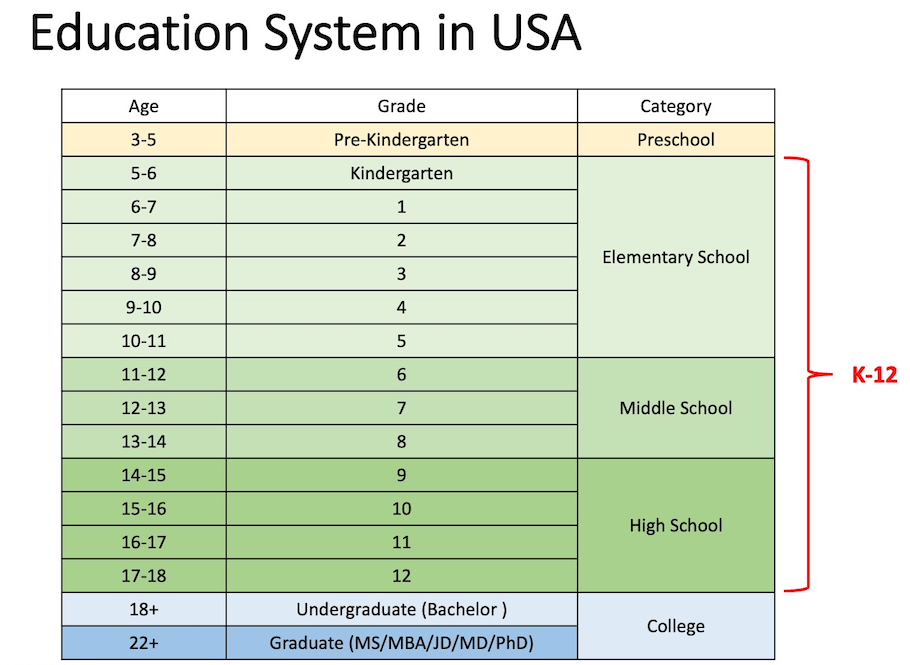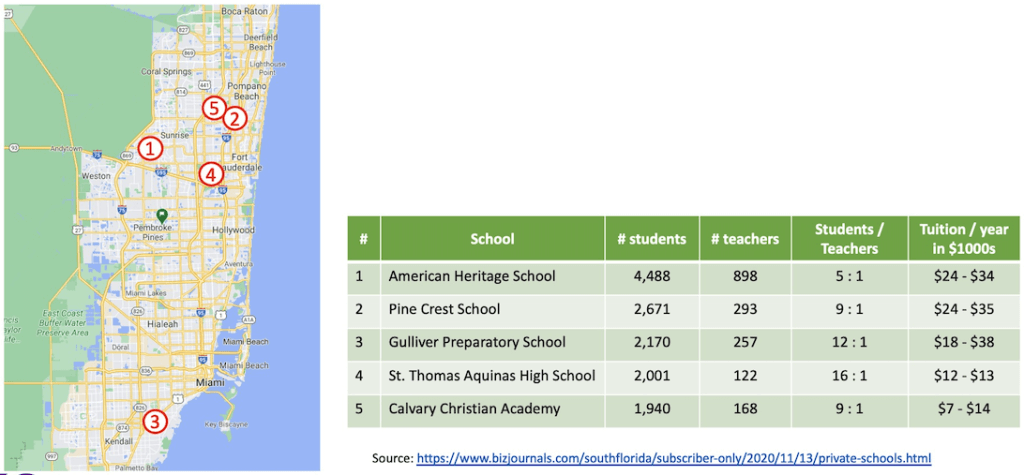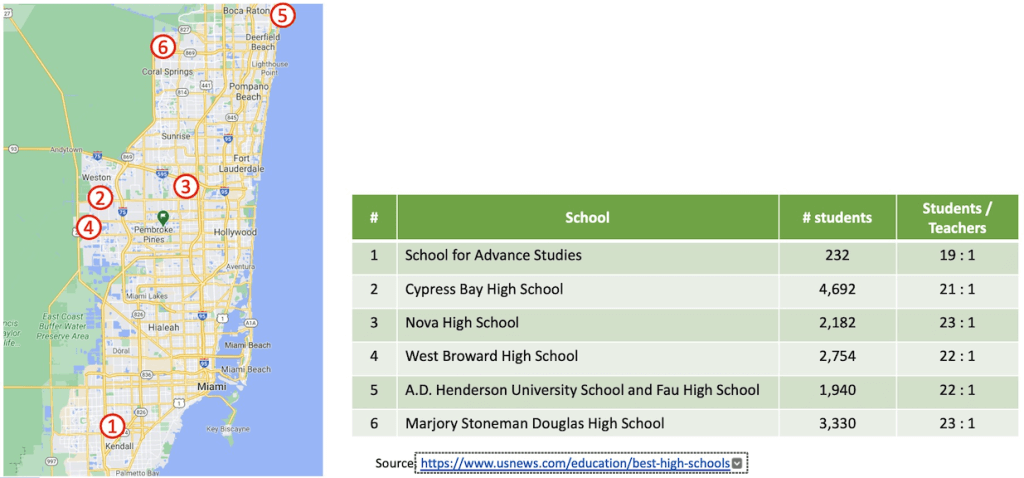Why good schools are in expensive areas

Education in the USA is organized into various levels, similar to systems in other countries, although there may be slight variations between states. Let’s break it down:
- Nursing School or Pre-kindergarten: This is the first stage of education, typically for young children before kindergarten. It helps prepare them for formal schooling.
- K-12 Education: This block covers children from the age of 5 onwards and consists of three main levels:
- Elementary School: This includes Kindergarten (for the little ones) and grades 1 to 5, generally for children aged 6 to 11.
- Middle School or Junior High: This level comprises grades 6, 7, and 8, catering to children aged 11 to 13.
- High School: Also known as high school, it encompasses grades 9 to 12 and is intended for teenagers from 14 years old until they graduate.

By the age of 18, it is expected that every child completes high school and is ready to pursue higher education in colleges and universities based on their interests and abilities. College and university education has two main levels:
- Undergraduate Level: This level provides basic education in the form of a Bachelor’s degree. It typically takes about 4 years to complete.
- Graduate Level: This level offers specialized education and includes various types of degrees such as Master’s, MBA (for business executives), JD (for lawyers), MD (for doctors), and PhD (for various academic degrees).
Here we are focusing on the K-12 education segment. The term “K-12” refers to education from kindergarten through 12th grade, covering a child’s entire primary and secondary education. The division of education into these levels is based on age groups and serves a few important purposes:
- Avoiding overcrowding: Dividing education into different levels helps prevent having a large number of children in a single building. By segregating students based on their age, schools can manage class sizes and provide a conducive learning environment.
- Economic considerations: The division of education by age allows for standardization in terms of infrastructure and resources. For example, classrooms can be designed with appropriate seating and table sizes that suit the age group of the students, making it more comfortable and conducive for learning.
In the United States, the responsibility for education primarily lies with state and local governments, while the federal government, specifically the Department of Education, plays a role in setting educational standards and policies. K-12 students in most districts have the option to choose between private schools, which are funded by private sources, and free public schools that are funded through taxes. Additionally, there are tax-funded charter schools that provide alternative education options within the public school system.
Private schools in the United States encompass a variety of institutions, including those affiliated with religious organizations, non-profit independent schools, and for-profit private schools. These schools charge different types of fees based on factors such as location, expenses, and availability of funding from sources other than tuition fees. In some cases, private schools receive partial subsidies from churches for their parishioners. Currently, over 5 million students attend approximately 30,000 different private schools across the United States. On average, private schools maintain a student-to-teacher ratio of 10-12 students per teacher, allowing for smaller class sizes and more individualized attention.
Private schools have diverse missions. Some focus on preparing students for college, aiming to provide them with a competitive advantage in the college admissions process. Others cater to gifted students or those with specific religious affiliations. Additionally, there are special schools designed for students with learning disabilities or other special needs. Unlike public school systems, private schools are not obligated to accept every interested student, and admission to highly sought-after private schools is often highly selective, considering various factors during the admission process.
We have compiled a list of the top 5 schools in South Florida based on the analysis by the South Florida Business Journal.
Best private schools

Before we move on to discussing public schools, let’s take a moment to address homeschooling. In recent years, there has been a significant increase in the number of children being educated at home, totaling over 2 million students, which accounts for about 5% of school-age children. Parents choose homeschooling primarily based on religious or moral beliefs, but it is also utilized for non-traditional forms of education, especially for exceptionally gifted children or those with special health needs. Homeschooling provides a flexible educational format tailored to the specific requirements of these children.
Public school systems in the United States receive support from local, state, and federal government funds. The primary source of income for most public schools is local property taxes. However, the resources available per student can vary significantly between different public schools. Class sizes also differ from one county to another. Curriculum decisions in public schools are primarily made at the local and state levels, with limited influence from the federal government. In most districts, schools are managed by a local school board. The School Board appoints a Superintendent of Schools to oversee the operations of the district’s schools.
The reliance on local property taxes to fund schools has its drawbacks. The quality of education can vary depending on the wealth or poverty of the cities or districts. One of the limitations is the potential lack of diverse student interest electives or continuing education courses to enhance the learning and education of students. These limitations restrict students and create educational disparities because it becomes challenging to provide equal access to all courses and programs, especially if they are not deemed essential by the education system. The public education system typically offers a standardized set of subjects necessary to obtain the General Educational Development (GED) Certificate. A GED is often required for employment and further education opportunities.
Enrollment in individual public schools can vary depending on the location. To address differences in school quality based on geographic location, many large city school systems have magnet schools. These schools allow a certain number of non-resident students to enroll in addition to local students. Magnet schools often have specialized themes and academic focuses, such as math, technology, science, or the arts, and are designed to cater to gifted children.
We have also provided a list of the top schools based on the analysis by US NEWS.
Best public schools in USA

Once again, we can observe that a majority of the best schools are located in Ft. Lauderdale. Let’s discuss the #1 school, situated in the Miami suburb of Kendall. It is important to note that this school is an integrated institution closely affiliated with the Miami-Dade community college, serving students in grades 11-12. Due to its specific nature, it can be excluded from the list.
Now, let’s address the initial question: why are the best schools in America located in more expensive areas? The primary reason is that public schools heavily rely on funding from local property taxes. Higher property taxes result in more financial resources being allocated to schools in the area. This translates to hiring more teachers, acquiring better equipment, and creating supportive and motivating learning environments for children. When considering real estate, it is essential to not only evaluate the value of the property you plan to purchase but also consider the number of expensive properties in the area. Interestingly, the largest portion of property taxes comes from these high-end properties, whose owners often do not send their children to public schools.
The demand for properties in areas with the best schools has always been strong and continues to rise, driving up prices in those areas the most. This leads to increased tax collection, which further improves the quality of education in these areas. Consequently, it creates additional demand for real estate, forming a cycle. The question remains: How long will this cycle continue? We invite you to share your thoughts on this matter in the comments.
Leave a comment
Sign in to post your comment or sign-up if you don't have any account.